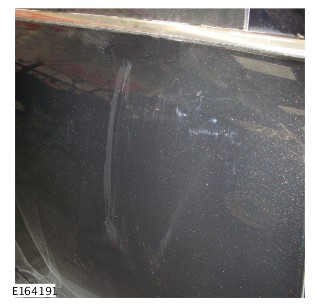| “This site contains affiliate links for which OEMDTC may be compensated” |
TECHNICAL BULLETIN
JTB00346NAS1
28 APR 2014
SECTION: 501-00
Transit Protection / Wrapguard Staining
AFFECTED VEHICLE RANGE:
| F-TYPE (X152) Model Year: 2014 Onwards VIN: K00001 Onwards |
| XF (X250) Model Year: 2014 Onwards VIN: U09026 Onwards |
| XJ Range (X351) Model Year: 2014 Onwards VIN: V58603 Onwards |
| XK Range (X150) Model Year: 2014 Onwards VIN: B52041 Onwards |
MARKETS:
NAS
CONDITION SUMMARY:
Situation: At Pre-Delivery Inspection (PDI) upon removal of the transit protection / wrapguard, there may be paint stains underneath the wrapguard. This staining can be described as ‘bloom’ or a ‘milky’ type of stain.
Cause: This may be caused by moisture being trapped under the transit protection / wrapguard. .
Action: To remove the stain, follow the Service Instruction outlined below.
PARTS:
No Parts Required
TOOLS:
No Tools Required
WARRANTY:
NOTE: Repair procedures are under constant review, and therefore times are subject to change; those quoted here must be taken as guidance only. Always refer to TOPIx to obtain the latest repair time.
NOTE: DDW requires the use of causal part numbers. Labor only claims must show the causal part number with a quantity of zero.
| DESCRIPTION | SRO | TIME (HOURS) | CONDITION CODE | CAUSAL PART |
|---|---|---|---|---|
| Transit protection and staining – Rectification – F-TYPE | 76.96.26 | 0.5 | D4 | T2R8822 |
| Transit protection and staining – Rectification – XF | 76.96.26 | 0.6 | D4 | C2Z16958 |
| Transit protection and staining – Rectification – XJ | 76.96.26 | 0.5 | D4 | C2D20215 |
| Transit protection and staining – Rectification – XK | 76.96.26 | 0.6 | D4 | C2P21670 |
NOTE: Normal Warranty policies and procedures apply.
SERVICE INSTRUCTION:
- Fully remove the transit protection / wrapguard from the vehicle.
- Inspect vehicle for ‘bloom’ or a ‘milky’ type of stain.
- CAUTION: When using an infrared curing unit, appropriate actions must be taken to protect plastic components from heat damage.
Subject the vehicle to a 30-minute bake cycle at 140°F / 60°C in a conventional spray booth.
If a conventional spray booth is not available, apply localized heat from an infrared curing unit.
- Once cool, polish the affected area.
